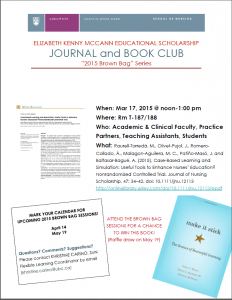Please see the outline of key points from the March 17th Brown Bag article. We had a good discussion about using case-based learning and high fidelity simulation in our undergraduate nursing program. We also discussed the importance of having measurable indicators for student competency assessment. We are currently working on a project in the School of Nursing to level core practice competencies so that we can better assess student learning gaps and provide supports proactively—before students get too far along in the program. Stay tuned…. Maura
EKM Brown Bag March 17, 2015
Raurell-Torreda, M., Olivet-Pujol, J., Romero-Collado, A., Malagon-Aguilera, M., Patino-Maso, J., & Baltasar-Bague, A. (2015). Case-based learning and simulation: useful tools to enhance nurses’ education? Non-randomized controlled trial. Journal of Nursing Scholarship, 47(1): 1, 34-42.
Key findings from article
- European Schools of Nursing are trying to standardize education and licensure requirements. Bologna Process-European Ministers of Higher Education.
- Shift from rote memorization to focus on competencies needed for safe practice.
- Came up with 6 categories.
- Exploration of methods to best teach core concepts/competencies. Problem-based, cooperative, case-based, role play, simulations.
- Case-based learning and simulation used in this article.
- Case-based: students feel more connected to reality and learn how to plan for care delivery. Increases autonomy, bridges theory-practice, increases student motivation. Considered the best ‘low tech’ way to help students integrate and apply competencies (KSA)
- Simulation-main principle is safe practice with debriefing/feedback. Decreases pressure.
- In the US, the National Council of State Boards of Nursing have been using simulation to help prepare students for making accurate decisions, work in team, communicate better, consider outcomes of incorrect choices.
- Used Lunney’s (2010) case study outline to create cases for 8 areas of nursing knowledge:
- Medications, med diagnosis, history, current disease info, nursing diagnostics, intervention, physician orders, lab data and tests (p. 36)
- Students worked in groups of 3-5 students to do a care plan.
- Randomly assigned to groups of 2-3 for simulations.
- “Blinded” professor scoring performance of Yes/No
- Used 5 purchased medical-surgical scenarios from NLN.
- Student/nurse performance was scored for:
- Patient safety and communication
- Patient assessment
- Recognition of signs and symptoms
- Problem identification
- Nursing diagnostics and interventions to address key problems
- Findings:
- Experimental better than Control group on patient assessment
- Experienced nurses superior on nursing evaluations and interventions to Controls: same as Experimental group
- Nurses with more years of experience did better with assessments and interventions.
- Trend: Both groups of students outscored nurses on patient safety (e.g., rules-based policies, such as checking ID bands, allergies)
- Trend: Control group showed worse critical thinking than the other two groups
Design
Control (Traditional classroom)→simulation performance: 80 minute lecture and discussion (66)
Experimental (Case-based)→simulation performance. 50 minute lecture/discussion and 30 min case work (35)
Experienced nurses→simulation performance (59)
Students 2nd year in clinical core course: Adult Patients 1. Had not had any clinical practice in hospital. Course focus is on nursing process.
OSCE with checklist-tested it for validity/reliability.
Implications from Authors
- Assessment is considered the most critical phase of nursing process—identifying the problem. (American Association of Colleges of Nursing, 1998).
- Case-based learning may be one way to help students standardize patient assessment protocols (and other aspects of nursing process). Students need to “always receive patient information in the same manner and learn to structure this information systematically” (p. 40).
- Case-based learning resulted in superior assessment skills among students; some evidence of enhanced critical thinking skills.
- Patient safety needs to be taught in schools of nursing-and reinforced in practice to ensure transfer of learning. If patient safety standards are not being consistently met by nurses in practice, simulations for students and nurses should be used to reinforce patient safety practices.
- Case-based learning should be used in tandem with simulation. “…the student who fails in a simulation will most likely not be competent in clinical practice. Therefore, we must identify the category in which failure occurred in order to strengthen aspects of the undergraduate curriculum and apply this feedback to improve academic preparation of students entering the professional environment.

